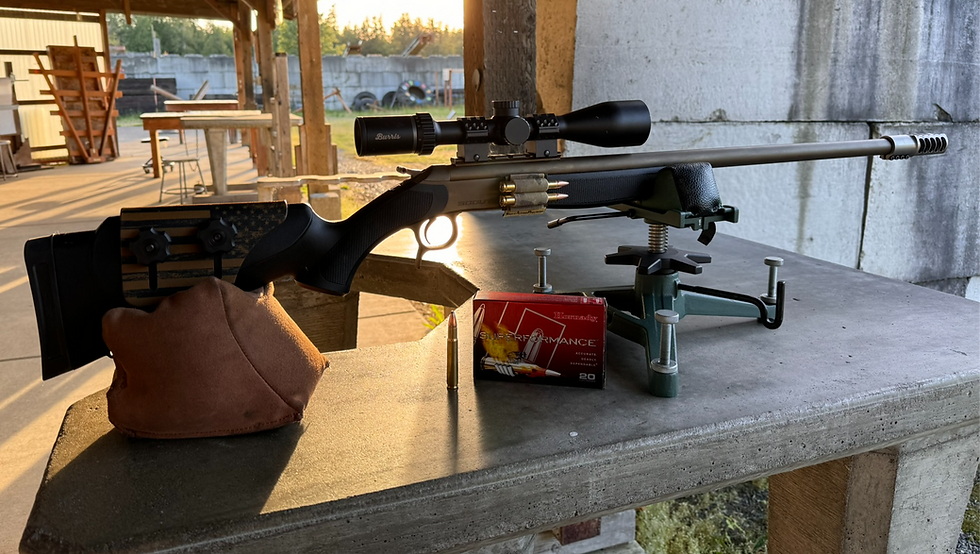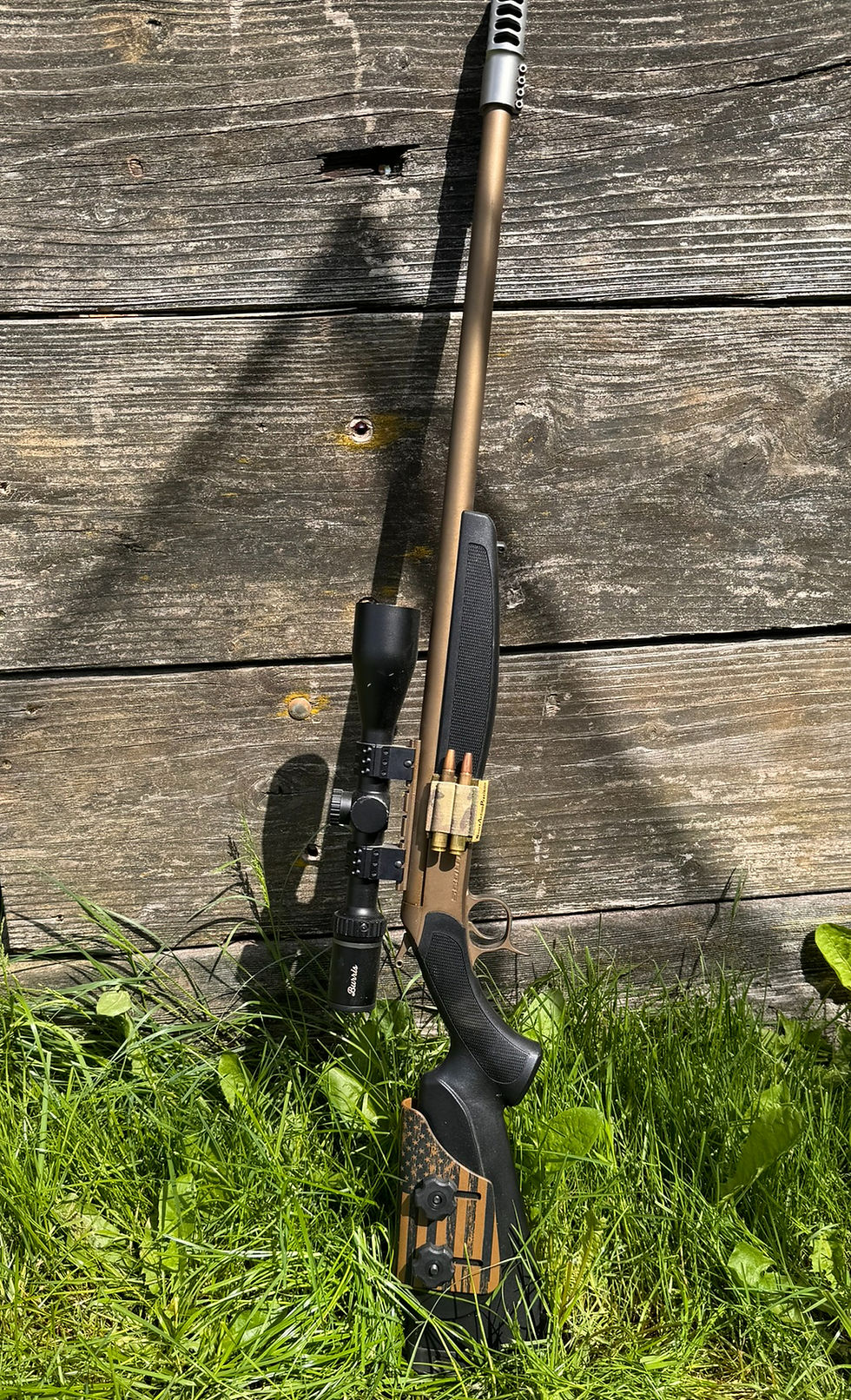.35 Whelen - The Most Underrated Non-Magnum Big Game Cartridge
- Zak May

- Oct 24
- 8 min read

The .35 Whelen was developed in 1922 as a wildcat cartridge, with the .30-06 Springfield as its parent case. Remington Arms Company standardized the .35 Whelen as a standard commercial round and first offered it in the Remington Model 700 Classic in 1988. It has since been chambered in bolt-action, semi-automatic, and single-shot rifles by other arms makers. Most of the guns were chambered in 1:12, 1:14, and 1:16 twist rates. Remington used the 1:16 twist rate for its rifles. Still, the most common twist rate was 1:12. The .35 Whelen was designed by James Howe, of Griffin and Howe, partially as a big-game cartridge for North American and African game.
The .35 Whelen performs right in the middle of the .30-06 Springfield and the .375 H&H. Some have called it the poor man's .375 H&H, but the .375 H&H outperforms it. When both are pushing a 300-grain bullet, the Whelen gets up to about 80% of the power of the .375 H&H, which is still impressive for a non-magnum round. And when it comes to the .30-06 Springfield and with the .35 Whelen, the Whelen outperforms it out to 200 to 250 yards, depending on what bullet is used for the .35 Whelen. The 30-06 Springfield using a .308 diameter 180-grain Nosler Partition with a B.C. of .474 (G1) will overtake the 35 Whelen past that 250-yard mark. This is one of the most used bullet weights for big game like elk. For the .35 Whelen, a 200-grain SP InterLock with a Ballistic Coefficient (B.C.) of .282 (G1), a .358 bullet would be the closest match to compare Hornady Superformance ammo. The muzzle velocity on the .30-06 with a 24-inch barrel is around 2,820 fps with energy around 3,178 ft-lbs. The .35 Whelen muzzle velocity with a 24-inch barrel is around 2,910 fps, and energy is around 3,760 ft-lbs. However, the .30-06 starts to make up ground after the 200-yard mark with a muzzle velocity of around 2,447 fps and energy of around 2,393 ft-lbs, and the .35 Whelen at 200 yards has a muzzle velocity of around 2,277 fps and energy of around 2,303 ft-lbs. One of the upsides of the .35 Whelen is its bullet diameter. I am a big believer that not only bullet weight but also bullet diameter play a considerable role in actively neutralizing game in a humane manner. The way I look at it, would you rather have a sewing needle pass through your hand at 3,000 FPS, leaving a tiny hole, even if it triples in size, or a railroad spike pass through your hand at 2,000 FPS, and imagine getting only twice the expansion of that? A lot of hunters will say shot placement, which I agree to a point, but there is no replacement for displacement. Meaning the bigger the bullet, the bigger the wound, and you hopefully won't be dealing with tracking a bear into the brush because the bear didn't run off.

The .35 Whelen performs exceptionally well in the 180-to-250-grain bullet range but can be loaded up to a 300-grain bullet. For me, it's a great black bear around here in the great Pacific Northwest. From the black bear to the well-known grizzly bear, it will work. If you are not a handloader, factory ammo can be hard to find, but a factory load using a 180-grain TTSX has a muzzle velocity of 2,900 fps and 3,360 ft-lbs of energy. That makes for a pretty fast 180-grain, .358-diameter bullet and one heck of a hard-hitting round. Of course, you can always get the outstanding 200-grain Remington Core-Lokt with a muzzle velocity of 2,675 fps and 3,180 ft-lbs of energy. Either of those would be great for big-game hunting, and you can even go heavier with a Nosler 225-grain AccuBond or the Remington 250-grain Pointed Soft PT. I was able to find four factory offerings of ammo to test. The first one tested was one of my favorite big-game bullets. The Barnes Vor-tx 180-Grain TTSX. This one is pretty speedy, with a box velocity of 2,900, but when tested, I got a little extra speed, averaging 2,966 FPS and a three-shot group size of 1.36 inches. The second factory testing was with Remington 200-grain Core-Lokt with a box velocity of 2,675 FPS. The actual velocity tested was 2,651 FPS. This ammo grouped the worst at a three-shot group of 1.48 inches. The third test was with Hornady Superformance 200-grain Soft Point; this stuff was also speedy for being a heavier 200-grain bullet. Box velocity is 2,910 FPS. During my test, I averaged 2,929 FPS. This also shot the best group at .95 of an inch. The fourth and final factory offering tested was the Remington 250-grain Pointed Soft PT with a box velocity of 2,400 FPS; the actual speed was very close to that. During the test, the velocity was 2,394 FPS with a three-shot group of 1.32 inches. Of the four factory offerings I tested, all shoot well for hunting inside 400 yards. But if I had to pick one for all-around hunting in North America, I'd go with the Hornady Superformance 200-grain Soft Point. Gives great speed and good accuracy, and a heavy enough bullet to effectively hunt pretty much anything in North America.
The one downside to this cartridge is that the bullet is not long and sleek like a 6.5 or 7mm bullet, which are both great for B.C. The .358 bullet is short and fat, which keeps the B.C. down, but, with its intended purpose, it does not need to be. The Speer 250-grain in a Spitzer SP bullet has a pretty good B.C. of .422 and a sectional density of .279, so for big game, it will work. You are not going to be competing long-range with this round, but that's not what it's designed for.

I believe the .35 Whelen shows its strength when it's handloaded, as you can play with the load to get a little extra out of the cartridge. As I said, there is a lot of variety with bullets and powders to choose from. The rifle I use for a big game bear gun is a CVA Scout with a 25-inch heavy barrel, a 1:12 twist rate, and a sweet preset trigger that breaks crisp, like glass, around 2 pounds 12 oz consistently. I installed a Witt Machine Custom Clamp-On Muzzle Brake to help with recoil, as it's got stout recoil. Mounted on top is a Burris Optics Fullfield E1 4.5-14x42mm scope, and on the side of the rifle, I put on a Short Action Precision SAP two-round holder. Topped off with a Matthew's Fabrication adjustable cheek riser to get that solid cheek weld every time for a more precise shot. I did a custom Cerakote in burnt bronze. I love how it turned out. Just makes the rifle look great and helps protect the finish while out in the brush.
This is a cartridge I have wanted for a long time, as I am a huge .30-06 fan. The .30-06 was the first gun I ever owned when I was 13 years old. To this day, it's still my main and favorite hunting rifle, and I even took a mule deer with it last year. But the .35 Whelen has always had a special place in my heart, so I set out to find one, and I do not regret choosing it as my bear gun. I know it has the accuracy and stopping power to make a good, clean kill, and to me, that's what matters most. The one downside to this cartridge is that, if you are looking for it in a bolt-action rifle, it can be hard to find. But this year at Shot Show, I saw at the Lipseys booth that they had a Ruger M77 Hawkeye in .35 Whelen available now. I want to get my hands on one of those for my collection.
My CVA Scout rifle in .35 Whelen is a single-shot, break-open action and is a great brush gun for hunting in the PNW, or anywhere else. Combined with the scope, it weighs 8 pounds and 14 ounces, so it's not the lightest rifle.

As for handloading these rounds, it's straightforward, like a .308 Winchester or a .30-06. You can start with brand-new or fired brass. I anneal all my brass after every firing, but I know many people choose not to. The main reason I do it is to help with neck tension, and brass life, and the sizing process is just more straightforward. There are many rabbit holes you can go down when it comes to handloading, but for the .35 Whelen, I followed the KISS method: Keep It Simple, Stupid. The brass sizing is standard, but if you use fired brass, make sure to clean it in a media tumbler or a wet tumbler with a stainless steel pin (my preferred method) to avoid damaging your sizing die. For the .35 Whelen, I use Remington brass. If you have a hard time finding factory or fired brass, you can always use .30-06 brass and size the neck up. But if you go that route, you will want to anneal the brass first to avoid overstressing it. When sizing fired brass, aim for about .002 inch of shoulder bump, and check with a case cage to see if it needs trimming.

If there is no need to trim, it's time to chamfer and debur them before priming the brass. I like to use the Forster bench-top priming tool because it seats the primer just below flush in the pocket. In most of my loads, I use Federal Large Rifle 210 Match primers because they have worked best for me. As for powder, I have seen the best results with Hodgdon Benchmark and the Barnes 180-grain TSX bullet, getting three-shot groups right around an inch with good velocity around 2850 FPS. For a Hornady 200-grain FTX bullet, I use IMR-4064 for the best groups, averaging around 3/4 inch. Velocity on the slower side averages 2,574. For the 225-grain Sierra Spitzer BT 225 loading, Hodgdon Varget shot averaged around 1.5 inches and produced groups at 2,490 FPS. Finally, for the Hornady 250-grain Spire SP bullet, I've gotten the best results with IMR4895 powder, averaging 1.25 inches and 2,350 FPS. For all these loads, I am happy to hunt game at ranges of 350 yards and in, though I would probably use only the 180-grain bullet for white-tail and mule deer, as the heavier bullets are not needed on medium game. For a bigger game, a 200-grain bullet would be more appropriate.
On a side note, the 35 Whelen is an excellent cartridge for mid-range pig hunting. The Barnes factory ammo VOR-TX 180-grain, with its speed and solid copper bullet, would be just a hammer on pigs. Pigs are known for being tough to put down fast, but this combo would work great!

Probably the best thing about this cartridge is that it can work for all game in North America, from deer and black bear to brown bear and even moose. It doesn't matter if you're shooting at 350 yards with the 250-grain Hornady Spire SP at 2,350 fps, or the 200-grain Hornady FTX at around 2,500 fps; it's going to get the job done if the shooter does their job. To sum it up, if you don't have a 35 Whelen, maybe it's time to pick yourself up one for that out west bear hunt or elk hunt.






Comments